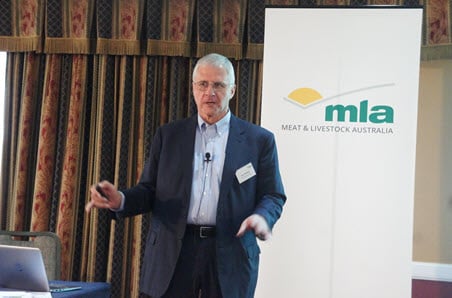In conversation with Len Steiner

Len Steiner, the founder of US-based commodity trading consultants the Steiner Consulting Group, has been involved in the ‘meat business’ his entire life.
During a recent visit to Australia, which included taking part in MLA’s Cattle Market Projections workshop, Len sat down with MLA Market Analyst Jen Peart to explain more about his role and the outlook for red meat.
Tell me about your career in the red meat industry?
My grandfather and his father were butchers, which exposed me to the retail trade of the red meat industry at an early age.
I completed a mechanical industrial engineering degree and then a Master’s in business administration, where my thesis focused on live cattle futures. I then went on to work in a number of roles such as with Cargill, the Chicago stock exchange, wholesale grocers and within the restaurant trade. The roles were diverse, ranging from designing meat-processing plants to developing and implementing buying and distribution systems.
When did you start consulting?
I started consulting in 1975, however the formation of the Steiner Consulting Group would come much later in 1987. The following year we were engaged by the Australian Meat and Livestock Corporation (AMLC) - who would later become Meat & Livestock Australia - in New York. Our initial involvement with AMLC was to help develop a relationship with McDonalds and see imported Australian grassfed grinding beef used within the US supply chain – which prevailed in 1994. This was the foundation for our 30-year relationship with the Australian red meat industry.
What are you views on the current US/Australian beef market?
Globally, the economy appears to be in far better shape than it did in 2016. In the US, this has translated into job creation and growth in the economy. This growth typically brings an increased spend in the restaurant sector – however in 2017 this was not the case. A vibrant and active restaurant and foodservice sector is crucial for the ongoing success of red meat globally.
In terms of the beef market, US demand for beef is outpacing the current increase in production. We are also seeing sustained higher prices in the US. This trend in turn will undoubtedly support the Australian market.
We are no longer seeing the discounts that were in place for Australian beef a few years ago. In fact Australian red meat is likely to carry a premium due to the favourable access Australian red meat enjoys in a wide range of international markets. Australia remains a world leader in terms of quality, particularly cleanliness, and traceability.
What are the prospects for grassfed beef in the US?
Grassfed beef is beginning to have a following in the US, there are however a few factors that have limited its growth. Firstly, good productive grazing areas are usually planted down to corn and therefore beef production gets pushed out, leaving land types that are more suited to cow/calf operators.
Secondly, consumers find there can be variability on taste in grassfed beef. The American public likes consistency and the lot feeding industry delivers that. I once worked with the largest hot dog manufacturer in the US – they do not necessarily have the best hot dogs, but every one is the same. In the US, consistency is King.
Len Steiner was talking to MLA during his annual trip to Australia, where he consults to the Beef Industry Forecasting Committee.
MLA’s 2018 Cattle Industry Projections will be released on Monday 29 January.



